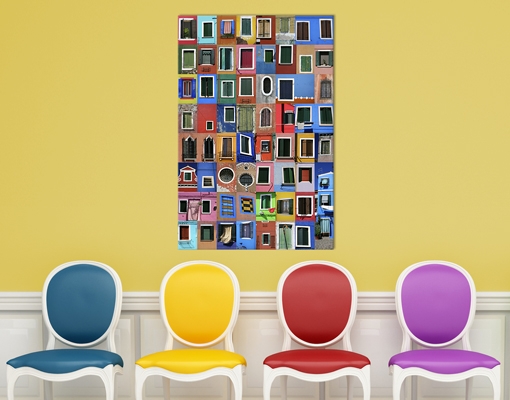I love this picture below.It makes such a statement!It tells me about building blocks and layers and colour and diversity and different shapes and sizes all coming together and all having windows on the world.I think this translates well as a a visual depiction of how we are trying to bring KS2 and KS3 together as windows of opportunity on the world of language learning
"Aren't there many windows on the same language learning World!"
As I write,I am in Germany- getting the "language buzz".Why? Well, German is my foreign language and I love the language with a passion.It's the reason that I continue to speak French and that I can try to access Spanish and generally love languages.It wasn't the first foreign language I learnt, but all those skills I continued to practise in French were so much more easily accessible when I was learning German.I relaxed in to the second foreign language and my learning was accelerated.
Even now at 52,I am still learning the skills of communication and still enjoy puzzling out the structure of language.When you are in the actual country you are reminded how you don't always have to be absolutely accurate to be understood,how you can rephrase or say something again,how it's okay to make a mistake,how there are always new words or phrases to take on board and first and foremost how very important it is that you feel confident when communicating.
This year as part of our DfE funded Warrington Teaching Schools Alliance project I have the great opportunity to work with Jo Gierl. Jo has been a HOD in one of our local high schools for several years and now teaches German and French from KS3 to KS5.She has two young bi-lingual children and already on a personal level see the bigger picture of the value of language learning from an early age.
We are very fortunate that Jo now works as an associate primary languages teacher within our network too - one afternoon a week in KS2.
Jo's first challenge was to start a blog diary of her observations this academic year(2104-2015) as she explores the language world of KS1 and KS2 and also as she disseminates her findings to her own department and then meets and shares with other local HODs and their colleagues..Jo's blog already has me hooked From Primary to Secondary.
What is so very real and refreshing about her observations are that she is looking at primary language learning as it really is happening - not on special occasions but as it is really happening and planned for on that day in the week she visits the schools.Jo is able to look at the learning she has read about and heard me speak about for herself . She is seeing the different approaches to the same big picture in 3D....
To help Jo when she works with her KS3 colleagues it will be important that she can share concrete examples. so over the last couple of weeks Jo has observed French,Spanish and German primary language learning here in Warrington.
Here are some of Jo's observations so far that are beginning to colour in the bigger picture for her of what language skills Year 6 children can already use or are developing.
Two weeks ago she observed @joanne_hornby delivering Spanish in a local primary school.
"Pupils knew how to use the bi-lingual dictionary, a skill we teach in Year 7 as many children have never come across them in previous years.
Cross-curricular links and further dictionary skills were made via Roald Dahl’s book titles in Spanish and the children had to recognise words and use the dictionaries to find out the English book titles. Pictures of the Spanish books were shown and the children were commenting on how front covers differed in Spanish compared with their English counterparts."
The following day,she observed @EWoodruffe as she taught primary French.I love the fact that watching KS1 was a revelation to Jo in this blog but here are some very specific comments about what she saw in Year 6.
" This was a full-on lesson…their previous knowledge ensured a prompt start to greetings and general conversational questions. A physical warm up conducted in French, demonstrated by Emilie ensured they were all up and participating, followed by a game of tennis, whereby the questions were batted out and a speedy whole class response was expected in return! When it came to the introduction of school subjects, they knew of cognates, pronunciation rules, grammatical terminology and ways to decipher meanings".
This week Jo has observed German with our very own Barbara Foerster:
"They were asked to match likes and dislike questions with their answers and most pupils were aware of looking for correlating words and patterns in the language. Connectives “und” and “aber” were slipped in and pupils were extending sentences within minutes. Negation was looked at “nicht” and “keine” readily identified by pupils. My partner had a super accent, mimicking that of Barbara and was so confident speaking to me in German"
Our big challenge this year is to see how we can take the diverse and language rich learning of KS2 languages and support KS3. Jo and I hope to explore and look for the "real" links between KS2 and KS3 language learning in our own local settings and then to share our observations and potential ways forward.
Yes we will need to ask children to learn the same or a different language at the start of KS3, but we need to plan for ways forward that mean children will be able to return to another coloured seat -if they have changed languages or select a completely new seat and try a new language challenge.The option to explore other languages too and move to the other coloured seats successfully needs to become the success story of KS3!






No comments:
Post a Comment